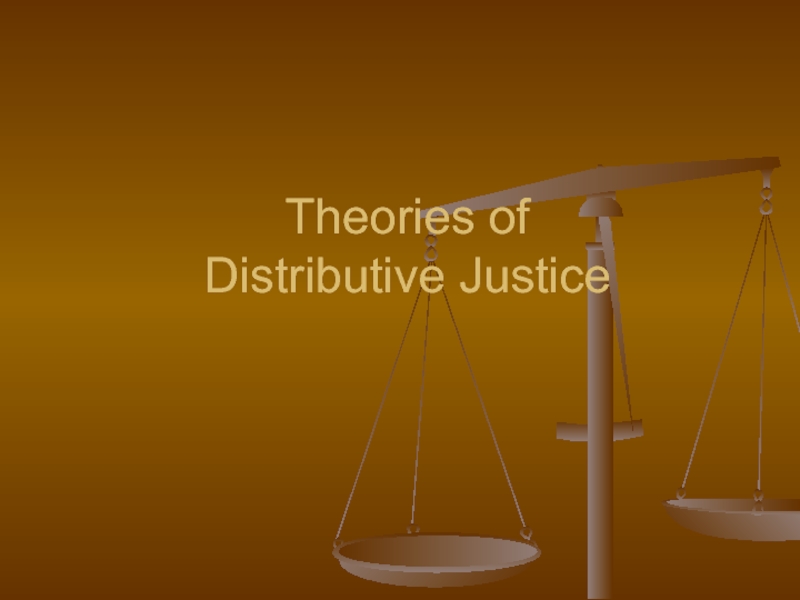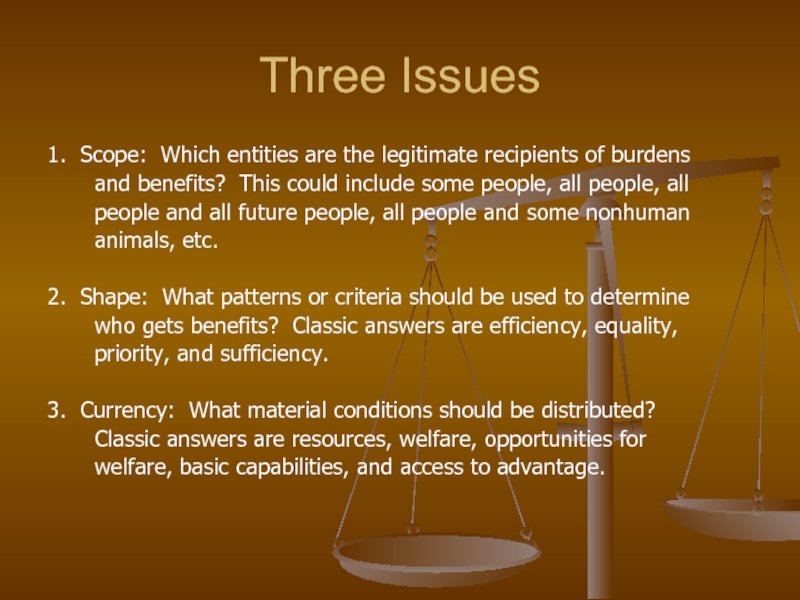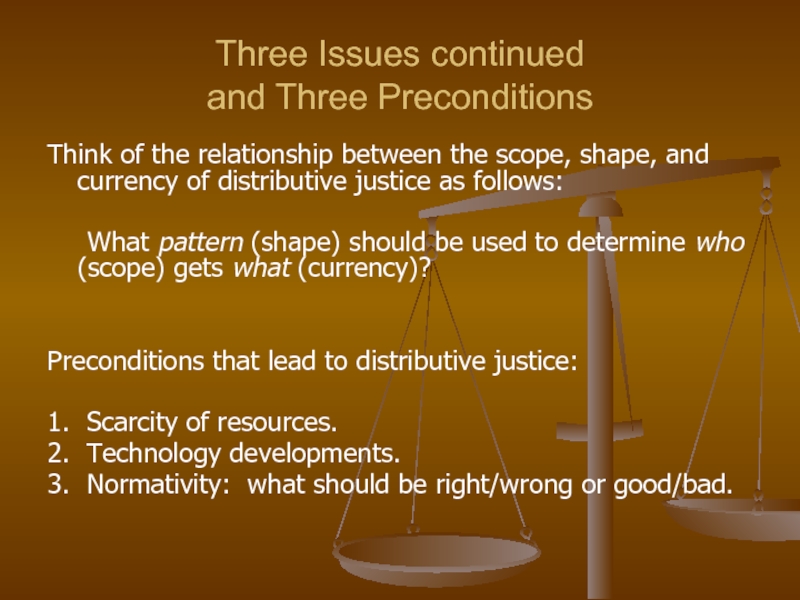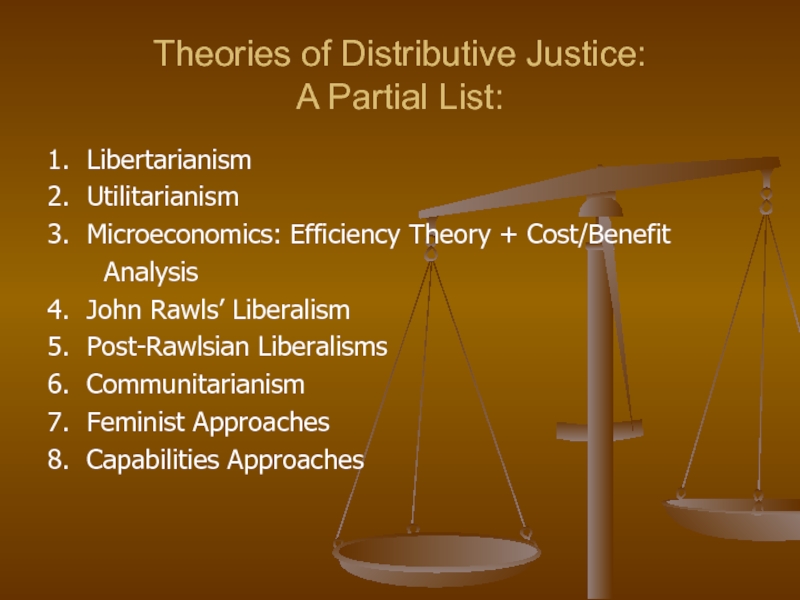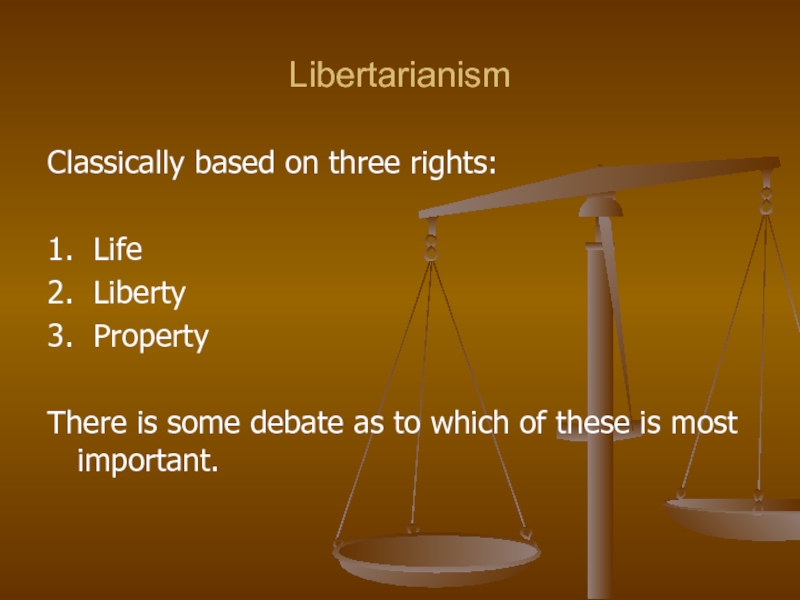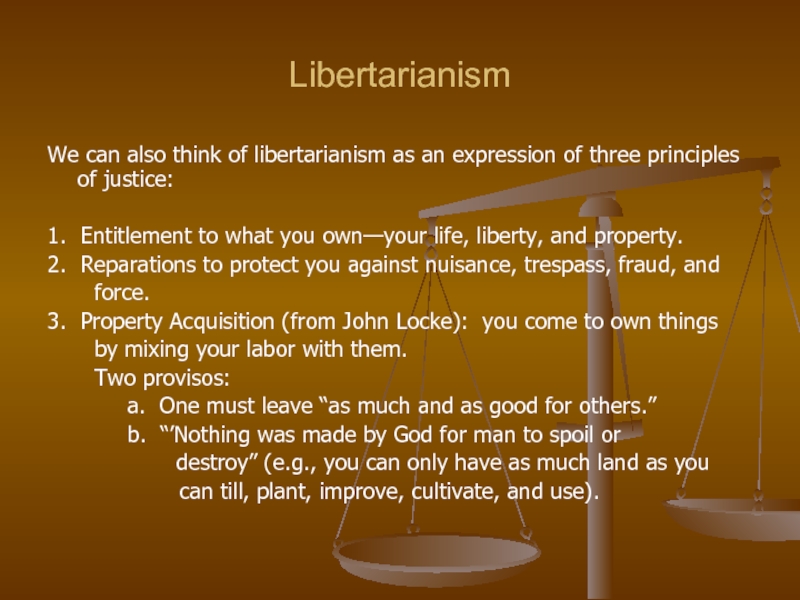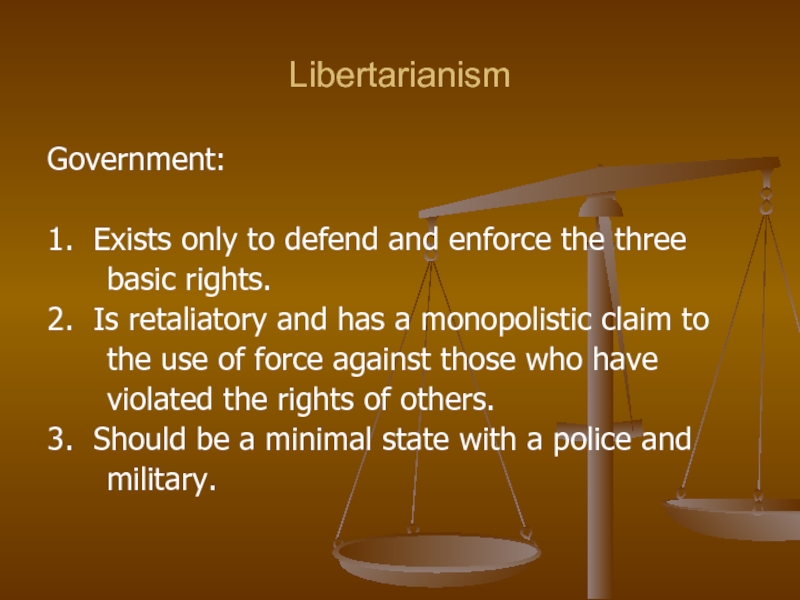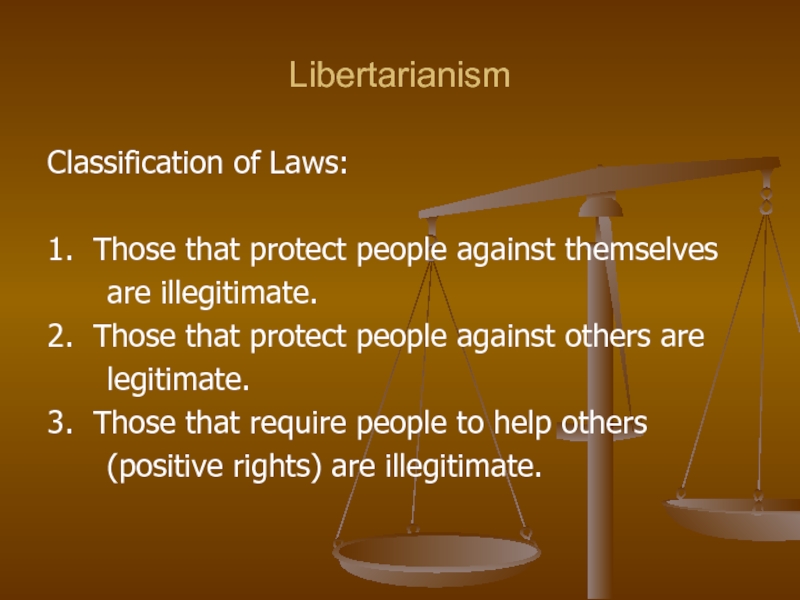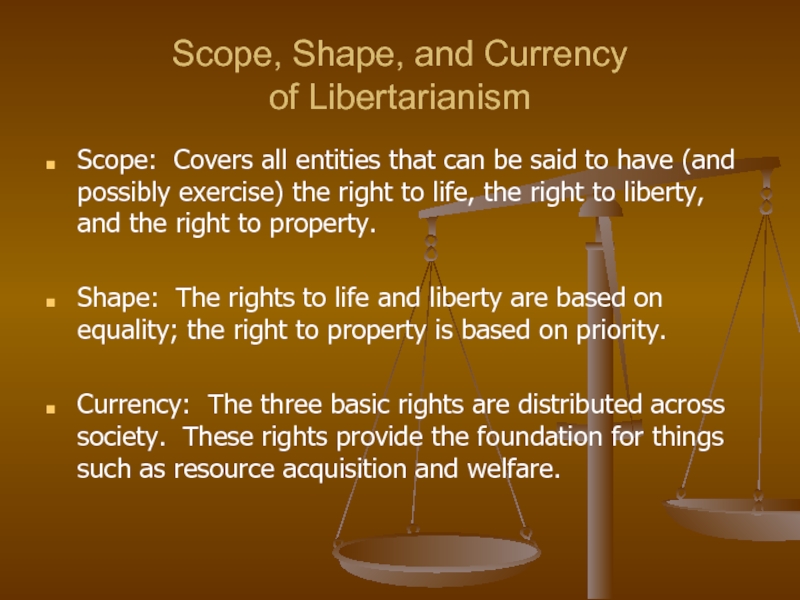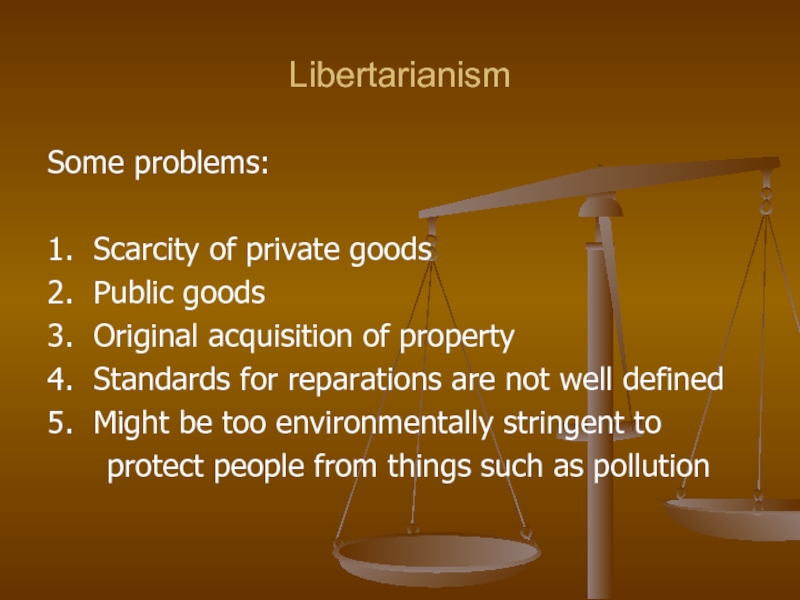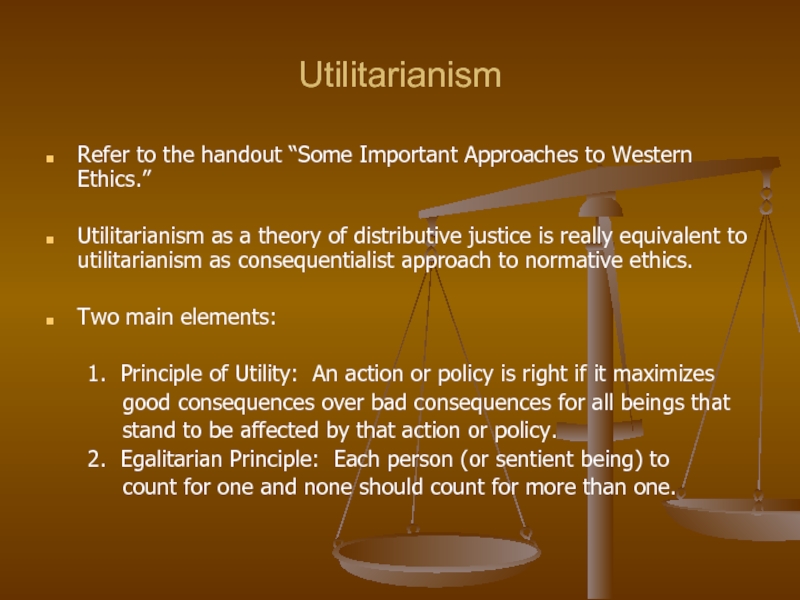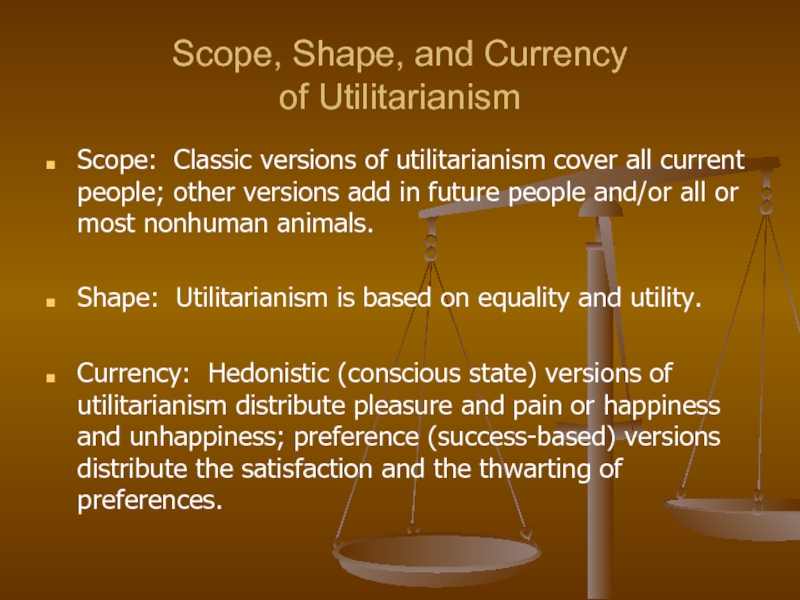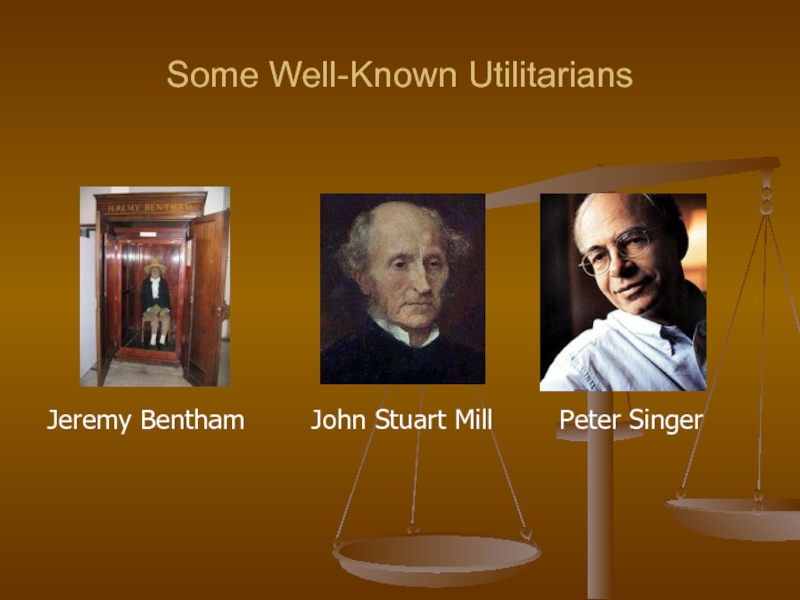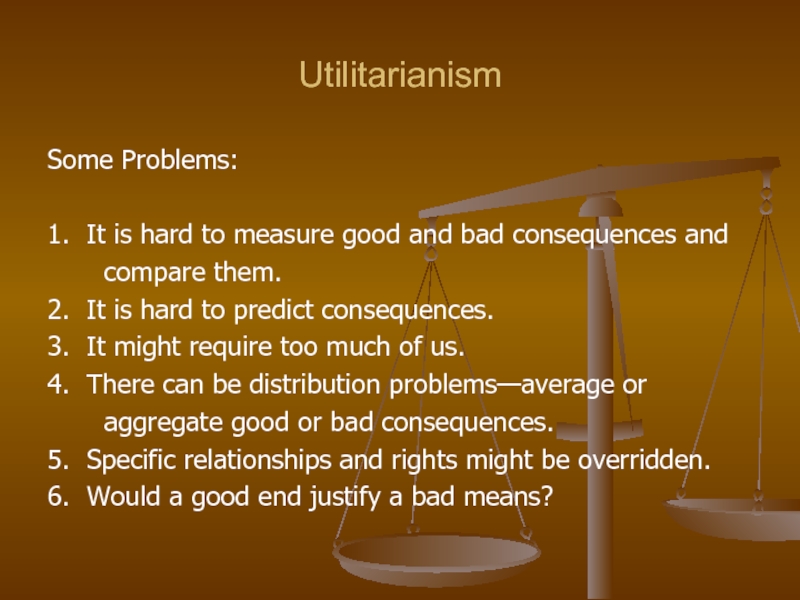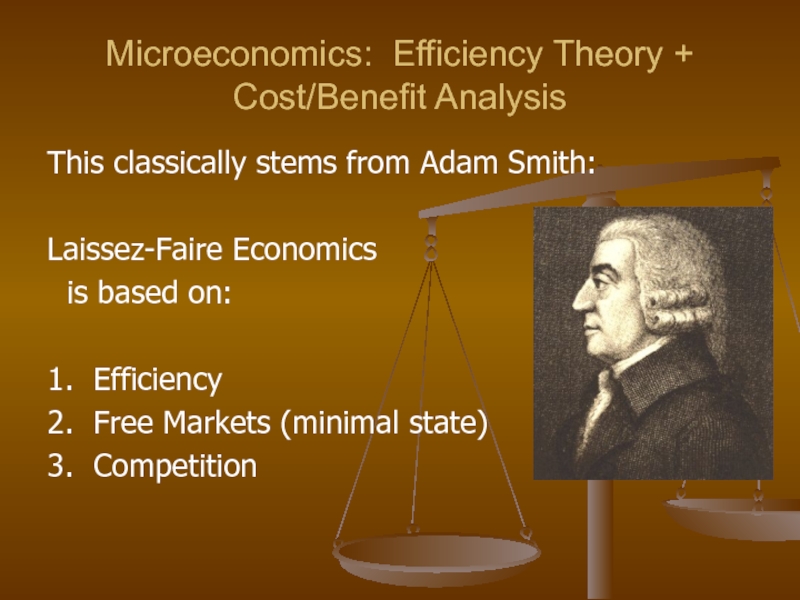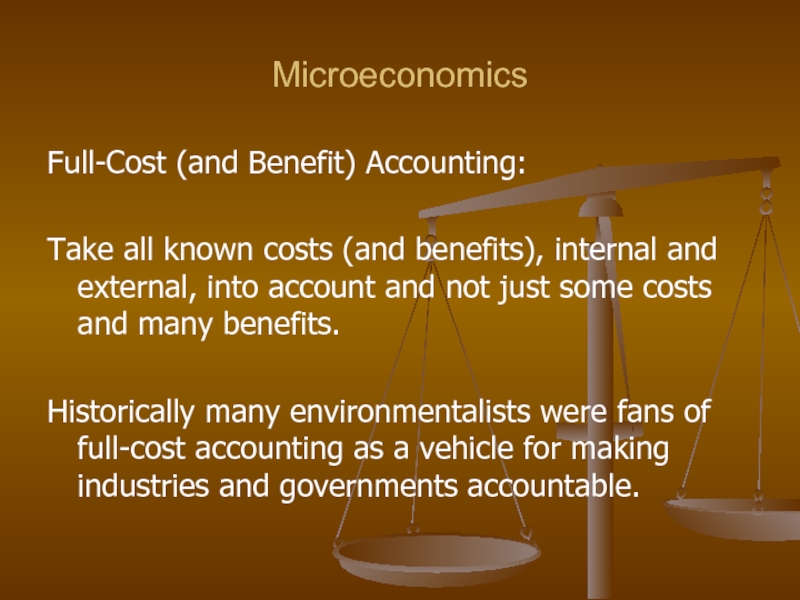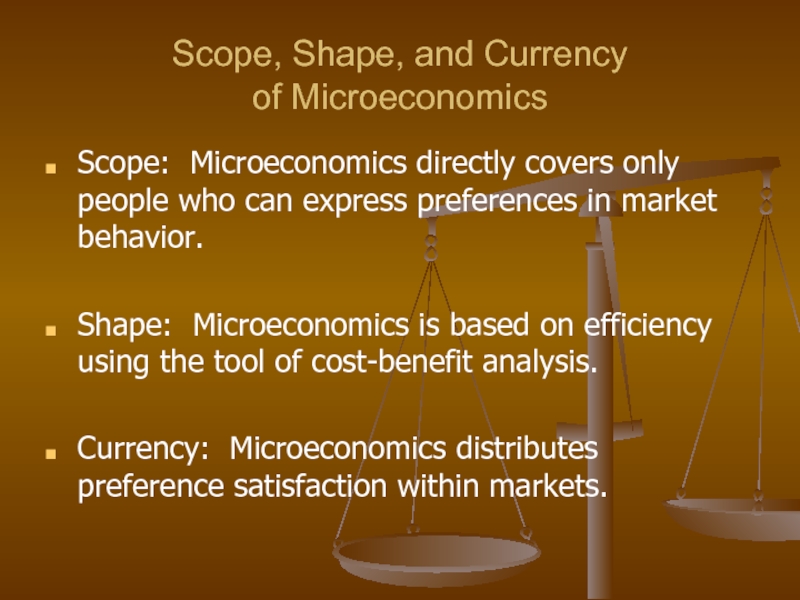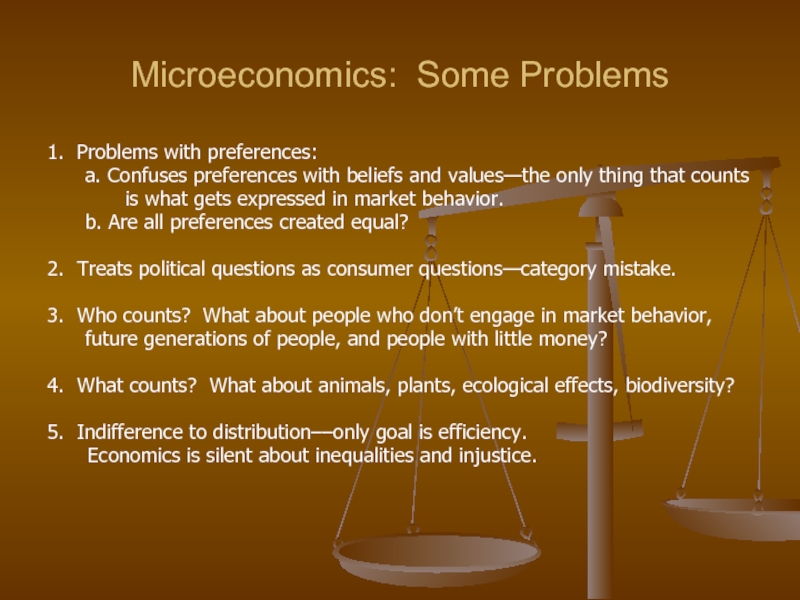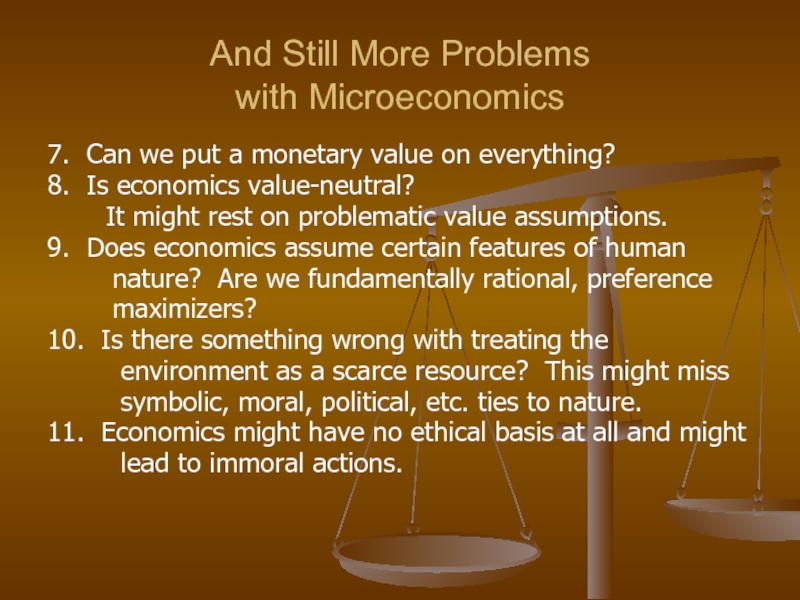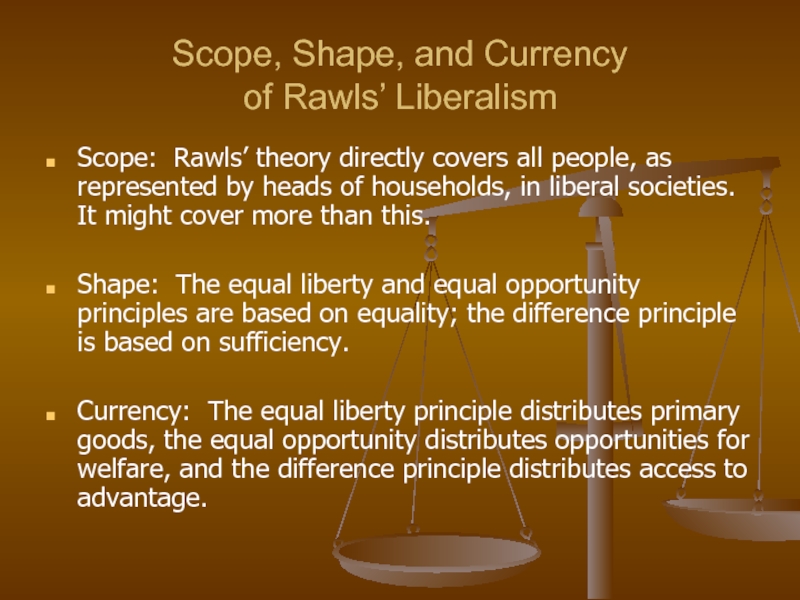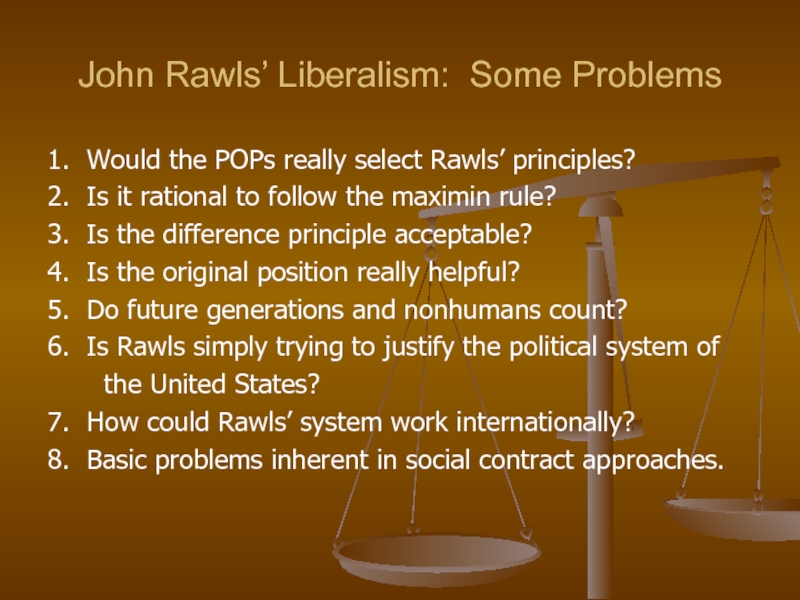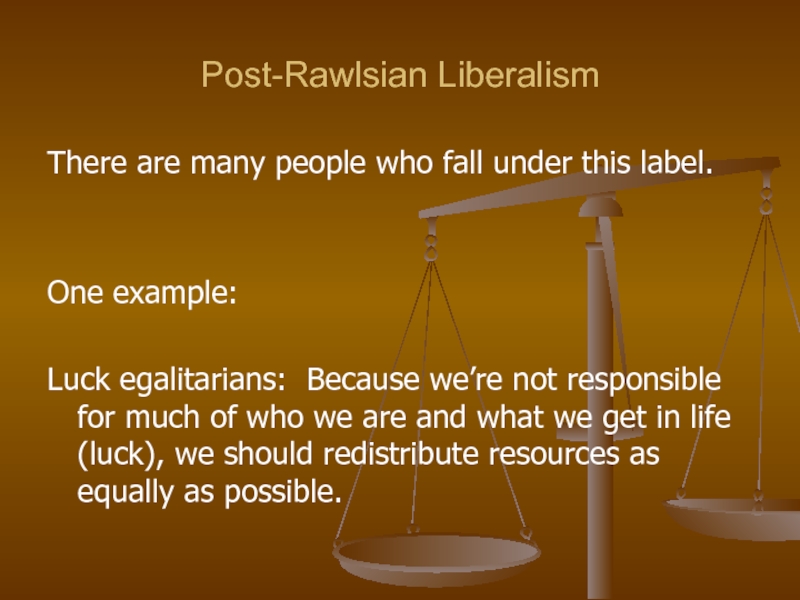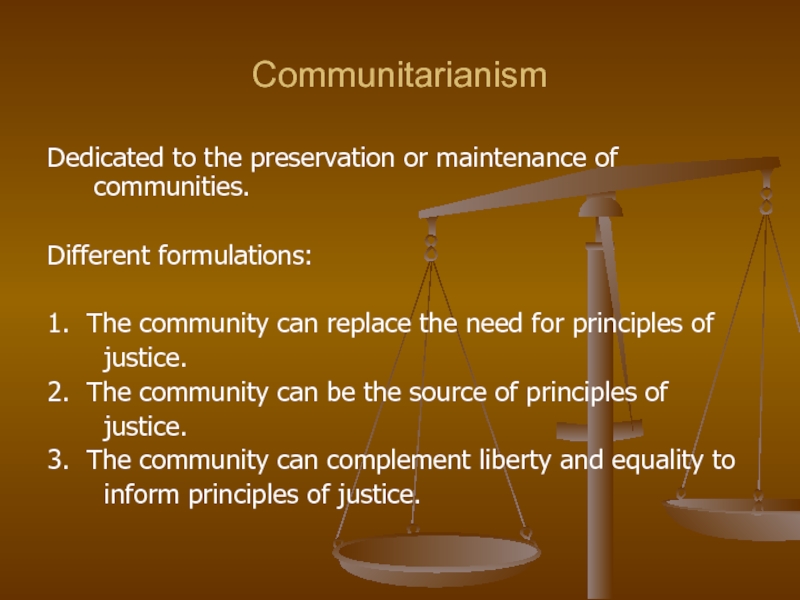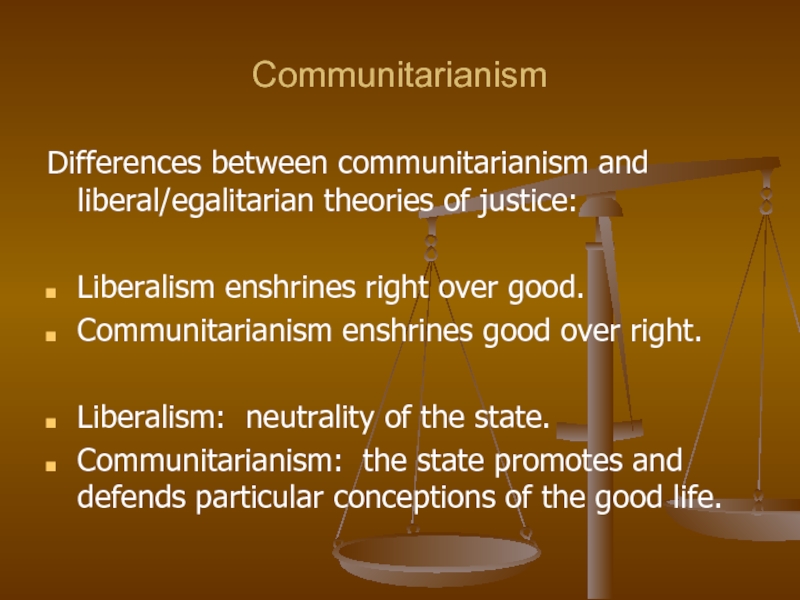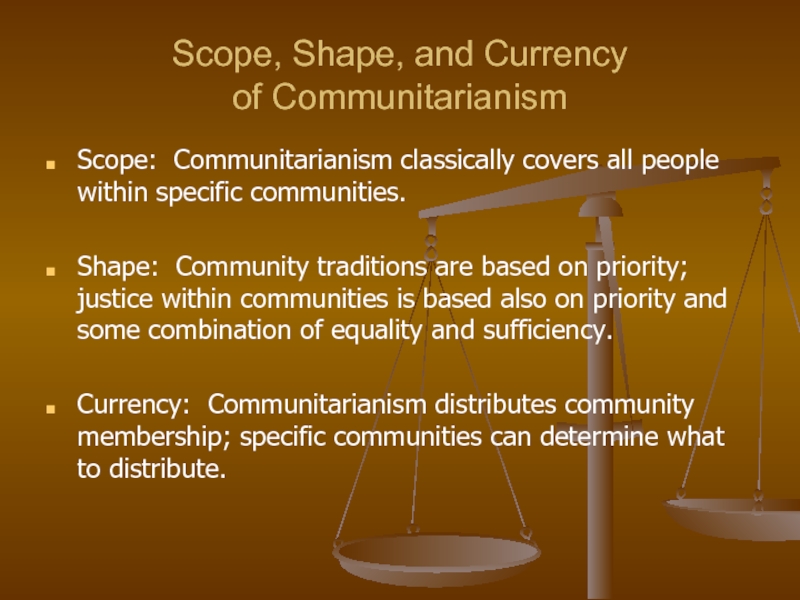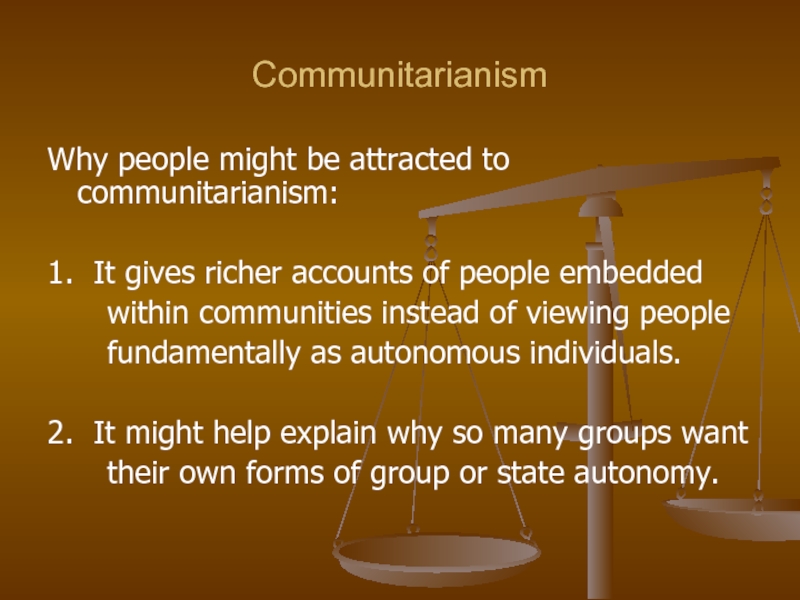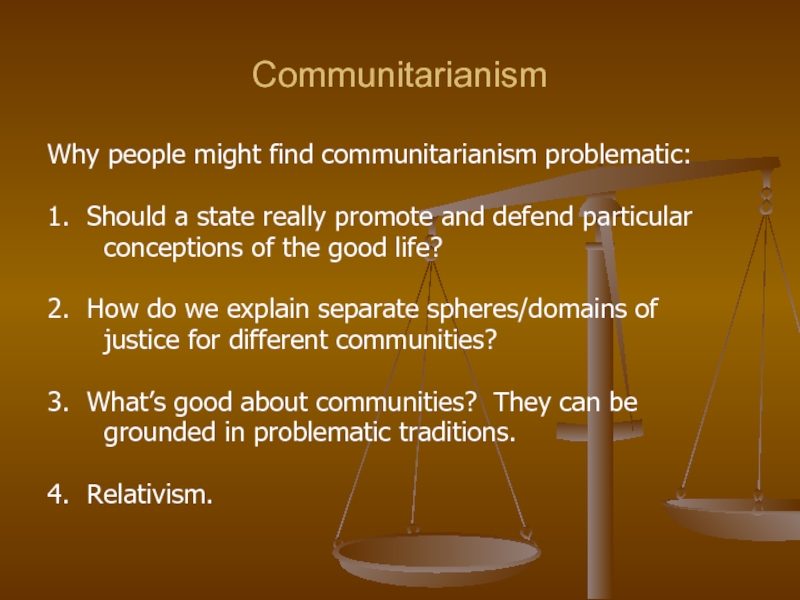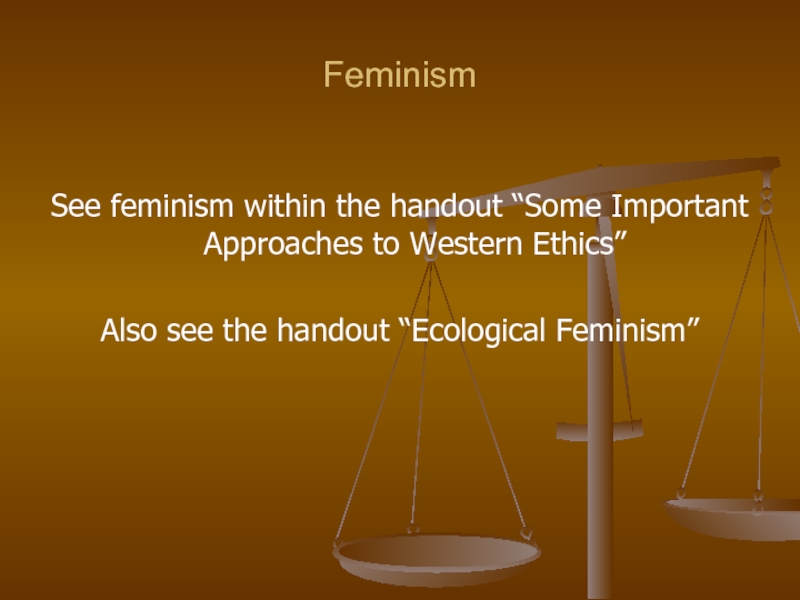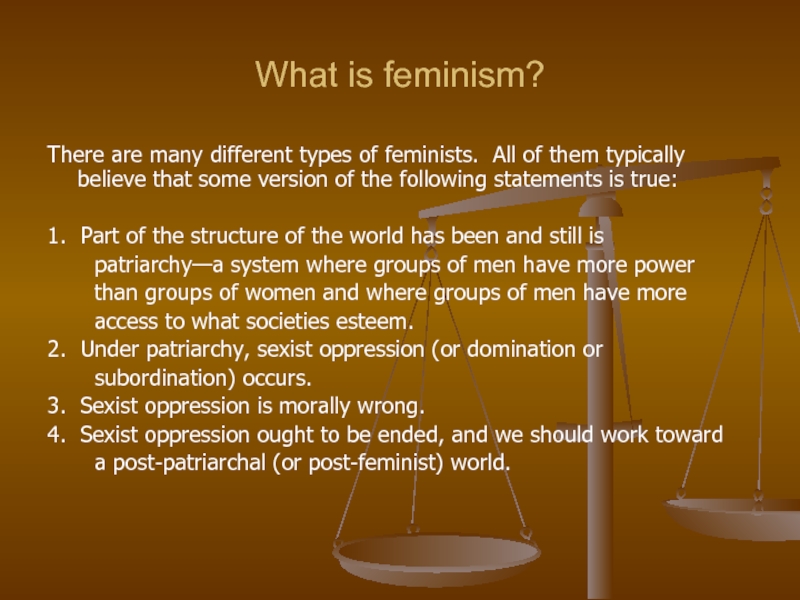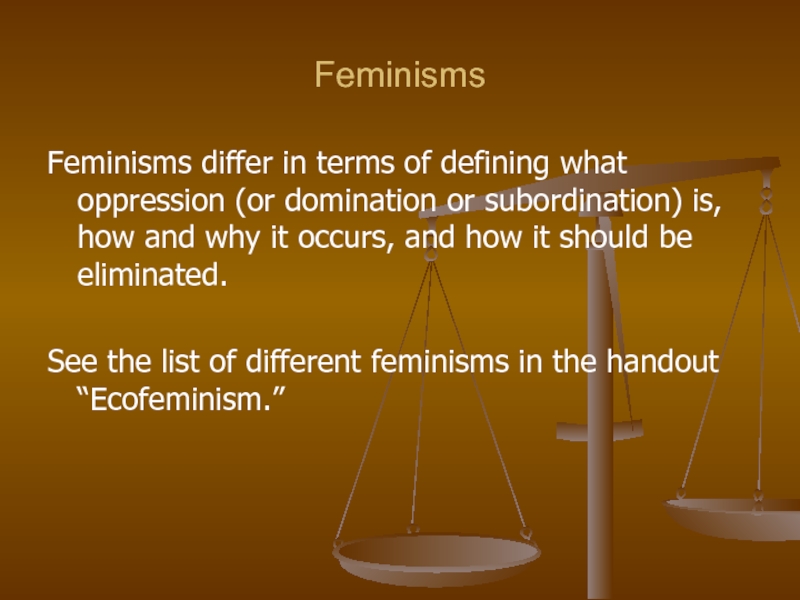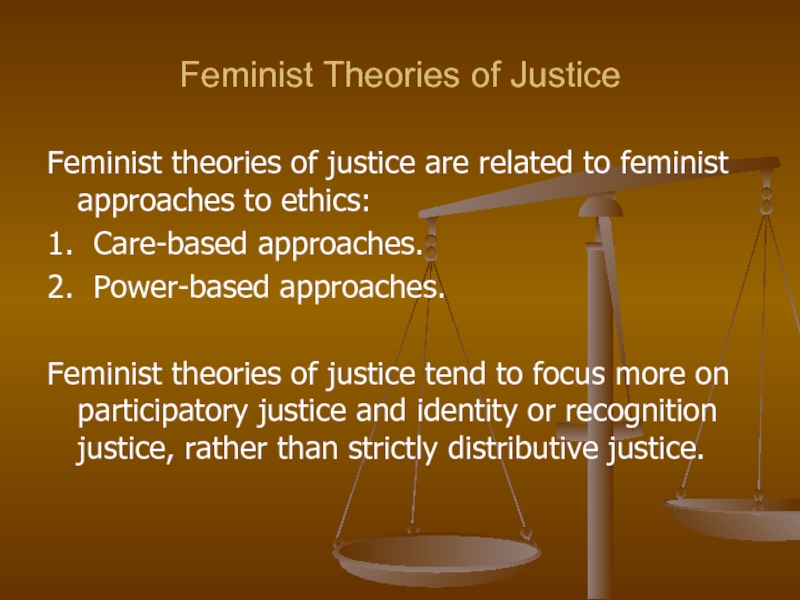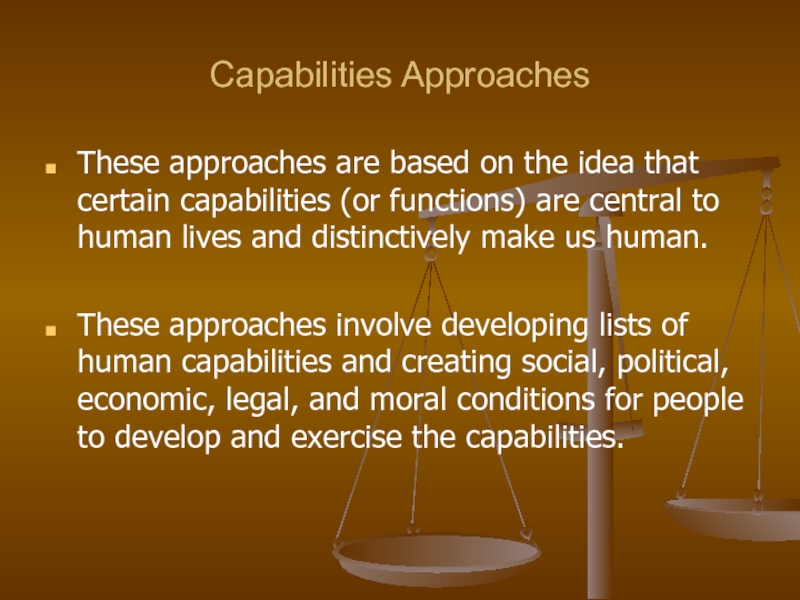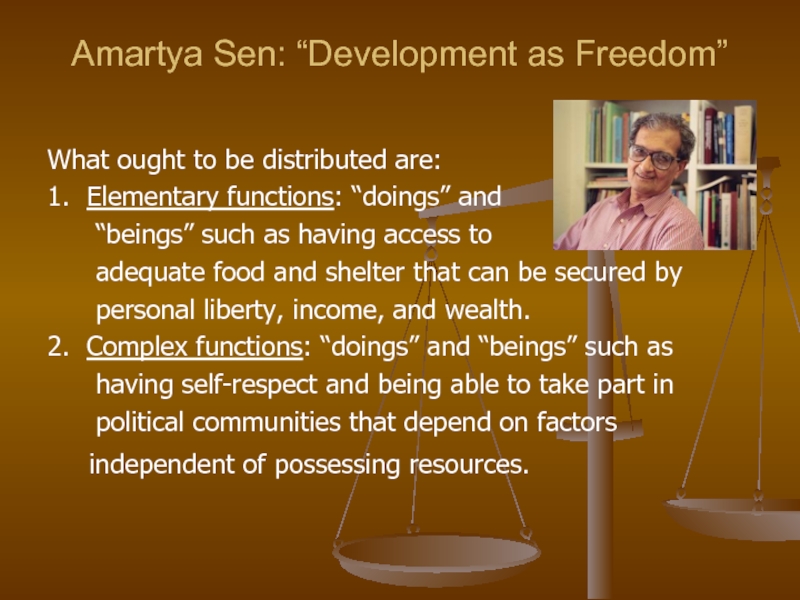Слайд 1Theories of
Distributive Justice
Слайд 2Three Issues
1. Scope: Which entities are the legitimate recipients of
burdens
and benefits? This could include some people, all
people, all
people and all future people, all people and some nonhuman
animals, etc.
2. Shape: What patterns or criteria should be used to determine
who gets benefits? Classic answers are efficiency, equality,
priority, and sufficiency.
3. Currency: What material conditions should be distributed?
Classic answers are resources, welfare, opportunities for
welfare, basic capabilities, and access to advantage.
Слайд 3Three Issues continued
and Three Preconditions
Think of the relationship
between the scope, shape, and currency of distributive justice as
follows:
What pattern (shape) should be used to determine who (scope) gets what (currency)?
Preconditions that lead to distributive justice:
1. Scarcity of resources.
2. Technology developments.
3. Normativity: what should be right/wrong or good/bad.
Слайд 4Theories of Distributive Justice:
A Partial List:
1. Libertarianism
2. Utilitarianism
3. Microeconomics: Efficiency
Theory + Cost/Benefit
Analysis
4. John Rawls’ Liberalism
5. Post-Rawlsian Liberalisms
6.
Communitarianism
7. Feminist Approaches
8. Capabilities Approaches
Слайд 5Libertarianism
Classically based on three rights:
1. Life
2. Liberty
3. Property
There is
some debate as to which of these is most important.
Слайд 6Libertarianism
We can also think of libertarianism as an expression of
three principles of justice:
1. Entitlement to what you own—your life,
liberty, and property.
2. Reparations to protect you against nuisance, trespass, fraud, and
force.
3. Property Acquisition (from John Locke): you come to own things
by mixing your labor with them.
Two provisos:
a. One must leave “as much and as good for others.”
b. “’Nothing was made by God for man to spoil or
destroy” (e.g., you can only have as much land as you
can till, plant, improve, cultivate, and use).
Слайд 7Libertarianism
Government:
1. Exists only to defend and enforce the three
basic rights.
2. Is retaliatory and has a monopolistic claim to
the use of force against those who have
violated the rights of others.
3. Should be a minimal state with a police and
military.
Слайд 8Libertarianism
Classification of Laws:
1. Those that protect people against themselves
are illegitimate.
2. Those that protect people against others are
legitimate.
3. Those that require people to help others
(positive rights) are illegitimate.
Слайд 9Scope, Shape, and Currency
of Libertarianism
Scope: Covers all entities that
can be said to have (and possibly exercise) the right
to life, the right to liberty, and the right to property.
Shape: The rights to life and liberty are based on equality; the right to property is based on priority.
Currency: The three basic rights are distributed across society. These rights provide the foundation for things such as resource acquisition and welfare.
Слайд 10Some Well-Known Libertarians
John Hospers
Robert Nozick
Although there is a
separate Libertarian Party in the United States, many republicans are real-life or closet libertarians.
Слайд 11Libertarianism
Some problems:
1. Scarcity of private goods
2. Public goods
3. Original acquisition
of property
4. Standards for reparations are not well defined
5. Might
be too environmentally stringent to
protect people from things such as pollution
Слайд 12Utilitarianism
Refer to the handout “Some Important Approaches to Western Ethics.”
Utilitarianism
as a theory of distributive justice is really equivalent to
utilitarianism as consequentialist approach to normative ethics.
Two main elements:
1. Principle of Utility: An action or policy is right if it maximizes
good consequences over bad consequences for all beings that
stand to be affected by that action or policy.
2. Egalitarian Principle: Each person (or sentient being) to
count for one and none should count for more than one.
Слайд 13Scope, Shape, and Currency
of Utilitarianism
Scope: Classic versions of utilitarianism
cover all current people; other versions add in future people
and/or all or most nonhuman animals.
Shape: Utilitarianism is based on equality and utility.
Currency: Hedonistic (conscious state) versions of utilitarianism distribute pleasure and pain or happiness and unhappiness; preference (success-based) versions distribute the satisfaction and the thwarting of preferences.
Слайд 14Some Well-Known Utilitarians
Jeremy Bentham John Stuart Mill
Peter Singer
Слайд 15Utilitarianism
Some Problems:
1. It is hard to measure good and bad
consequences and
compare them.
2. It is hard to predict
consequences.
3. It might require too much of us.
4. There can be distribution problems—average or
aggregate good or bad consequences.
5. Specific relationships and rights might be overridden.
6. Would a good end justify a bad means?
Слайд 16Microeconomics: Efficiency Theory + Cost/Benefit Analysis
This classically stems from Adam
Smith:
Laissez-Faire Economics
is based on:
1. Efficiency
2. Free Markets (minimal
state)
3. Competition
Слайд 17Microeconomics: Efficiency Theory + Cost/Benefit Analysis
See the handout I
distributed in class today.
Слайд 18Microeconomics
Full-Cost (and Benefit) Accounting:
Take all known costs (and benefits), internal
and external, into account and not just some costs and
many benefits.
Historically many environmentalists were fans of full-cost accounting as a vehicle for making industries and governments accountable.
Слайд 19Scope, Shape, and Currency
of Microeconomics
Scope: Microeconomics directly covers only
people who can express preferences in market behavior.
Shape: Microeconomics is
based on efficiency using the tool of cost-benefit analysis.
Currency: Microeconomics distributes preference satisfaction within markets.
Слайд 20Microeconomics: Some Problems
1. Problems with preferences:
a. Confuses
preferences with beliefs and values—the only thing that counts
is what gets expressed in market behavior.
b. Are all preferences created equal?
2. Treats political questions as consumer questions—category mistake.
3. Who counts? What about people who don’t engage in market behavior,
future generations of people, and people with little money?
4. What counts? What about animals, plants, ecological effects, biodiversity?
5. Indifference to distribution––only goal is efficiency.
Economics is silent about inequalities and injustice.
Слайд 21More Problems with Microeconomics
6. Problems with cost-benefit analysis (CBA):
a. Costs and benefits are not always anticipated.
b. Difficulty/impossibility
of precisely quantifying costs
and benefits.
c. Some costs and benefits might be
incommensurable.
d. Subjects both the means and ends of decisions to
economic analysis. (CBA vs. Cost Effectiveness from handout.)
e. CBA tends to overwhelm or replace other ways of
evaluation—especially moral/political evaluation.
Слайд 22And Still More Problems
with Microeconomics
7. Can we put a
monetary value on everything?
8. Is economics value-neutral?
It might rest on problematic value assumptions.
9. Does economics assume certain features of human
nature? Are we fundamentally rational, preference
maximizers?
10. Is there something wrong with treating the
environment as a scarce resource? This might miss
symbolic, moral, political, etc. ties to nature.
11. Economics might have no ethical basis at all and might
lead to immoral actions.
Слайд 23John Rawls’ Liberalism
See the handout I distributed in class today.
Слайд 24Scope, Shape, and Currency
of Rawls’ Liberalism
Scope: Rawls’ theory directly covers
all people, as represented by heads of households, in liberal
societies. It might cover more than this.
Shape: The equal liberty and equal opportunity principles are based on equality; the difference principle is based on sufficiency.
Currency: The equal liberty principle distributes primary goods, the equal opportunity distributes opportunities for welfare, and the difference principle distributes access to advantage.
Слайд 25John Rawls’ Liberalism: Some Problems
1. Would the POPs really select
Rawls’ principles?
2. Is it rational to follow the maximin rule?
3.
Is the difference principle acceptable?
4. Is the original position really helpful?
5. Do future generations and nonhumans count?
6. Is Rawls simply trying to justify the political system of
the United States?
7. How could Rawls’ system work internationally?
8. Basic problems inherent in social contract approaches.
Слайд 26Post-Rawlsian Liberalism
There are many people who fall under this label.
One
example:
Luck egalitarians: Because we’re not responsible for much of who
we are and what we get in life (luck), we should redistribute resources as equally as possible.
Слайд 27Communitarianism
Dedicated to the preservation or maintenance of communities.
Different formulations:
1. The
community can replace the need for principles of
justice.
2.
The community can be the source of principles of
justice.
3. The community can complement liberty and equality to
inform principles of justice.
Слайд 28Communitarianism
Differences between communitarianism and liberal/egalitarian theories of justice:
Liberalism enshrines right
over good.
Communitarianism enshrines good over right.
Liberalism: neutrality of the state.
Communitarianism:
the state promotes and defends particular conceptions of the good life.
Слайд 29Scope, Shape, and Currency
of Communitarianism
Scope: Communitarianism classically covers all people
within specific communities.
Shape: Community traditions are based on priority; justice
within communities is based also on priority and some combination of equality and sufficiency.
Currency: Communitarianism distributes community membership; specific communities can determine what to distribute.
Слайд 30Communitarianism
Why people might be attracted to communitarianism:
1. It gives richer
accounts of people embedded
within communities instead of viewing
people
fundamentally as autonomous individuals.
2. It might help explain why so many groups want
their own forms of group or state autonomy.
Слайд 31A Well-Known Communitarian
Michael Walzer
Слайд 32Communitarianism
Why people might find communitarianism problematic:
1. Should a state really
promote and defend particular
conceptions of the good life?
2.
How do we explain separate spheres/domains of
justice for different communities?
3. What’s good about communities? They can be
grounded in problematic traditions.
4. Relativism.
Слайд 33Feminism
See feminism within the handout “Some Important Approaches to Western
Ethics”
Also see the handout “Ecological Feminism”
Слайд 34What is feminism?
There are many different types of feminists. All
of them typically believe that some version of the following
statements is true:
1. Part of the structure of the world has been and still is
patriarchy—a system where groups of men have more power
than groups of women and where groups of men have more
access to what societies esteem.
2. Under patriarchy, sexist oppression (or domination or
subordination) occurs.
3. Sexist oppression is morally wrong.
4. Sexist oppression ought to be ended, and we should work toward
a post-patriarchal (or post-feminist) world.
Слайд 35Feminisms
Feminisms differ in terms of defining what oppression (or domination
or subordination) is, how and why it occurs, and how
it should be eliminated.
See the list of different feminisms in the handout “Ecofeminism.”
Слайд 36Feminist Theories of Justice
Feminist theories of justice are related to
feminist approaches to ethics:
1. Care-based approaches.
2. Power-based approaches.
Feminist theories of
justice tend to focus more on participatory justice and identity or recognition justice, rather than strictly distributive justice.
Слайд 37Capabilities Approaches
These approaches are based on the idea that certain
capabilities (or functions) are central to human lives and distinctively
make us human.
These approaches involve developing lists of human capabilities and creating social, political, economic, legal, and moral conditions for people to develop and exercise the capabilities.
Слайд 38Amartya Sen: “Development as Freedom”
What ought to be distributed are:
1.
Elementary functions: “doings” and
“beings” such as having access
to
adequate food and shelter that can be secured by
personal liberty, income, and wealth.
2. Complex functions: “doings” and “beings” such as
having self-respect and being able to take part in
political communities that depend on factors
independent of possessing resources.
Слайд 39Martha Nussbaum: “Capabilities Approach”
Central human functional capabilities that
ought
to be distributed:
1. Life
2. Bodily health
3. Bodily integrity
4. Senses, imagination,
and thought
5. Emotions
6. Practical reason
7. Affiliation toward other species and as the basis for self-respect
and dignity
8. Other species
9. Play
10. Control over your political and material environment
Слайд 40Sen’s and Nussbaum’s
Capabilities Approaches
For Sen, a person who cannot
exercise elementary and complex functions falls short of living a
decent human life; for Nussbaum, a person who lacks capabilities falls short of living a decent life.
Political and economic institutions ought to facilitate and/or provide opportunities for people to exercise functions (Sen) or capabilities (Nussbaum).
Слайд 41Scope, Shape, and Currency
of Capabilities Approaches
Scope: Minimally these approaches cover
all people.
Shape: Capabilities approaches are based on hybrids of equality
and sufficiency.
Currency: Capabilities approaches distribute opportunities to exercise what it fundamentally means to be human (central functions or capabilities).
